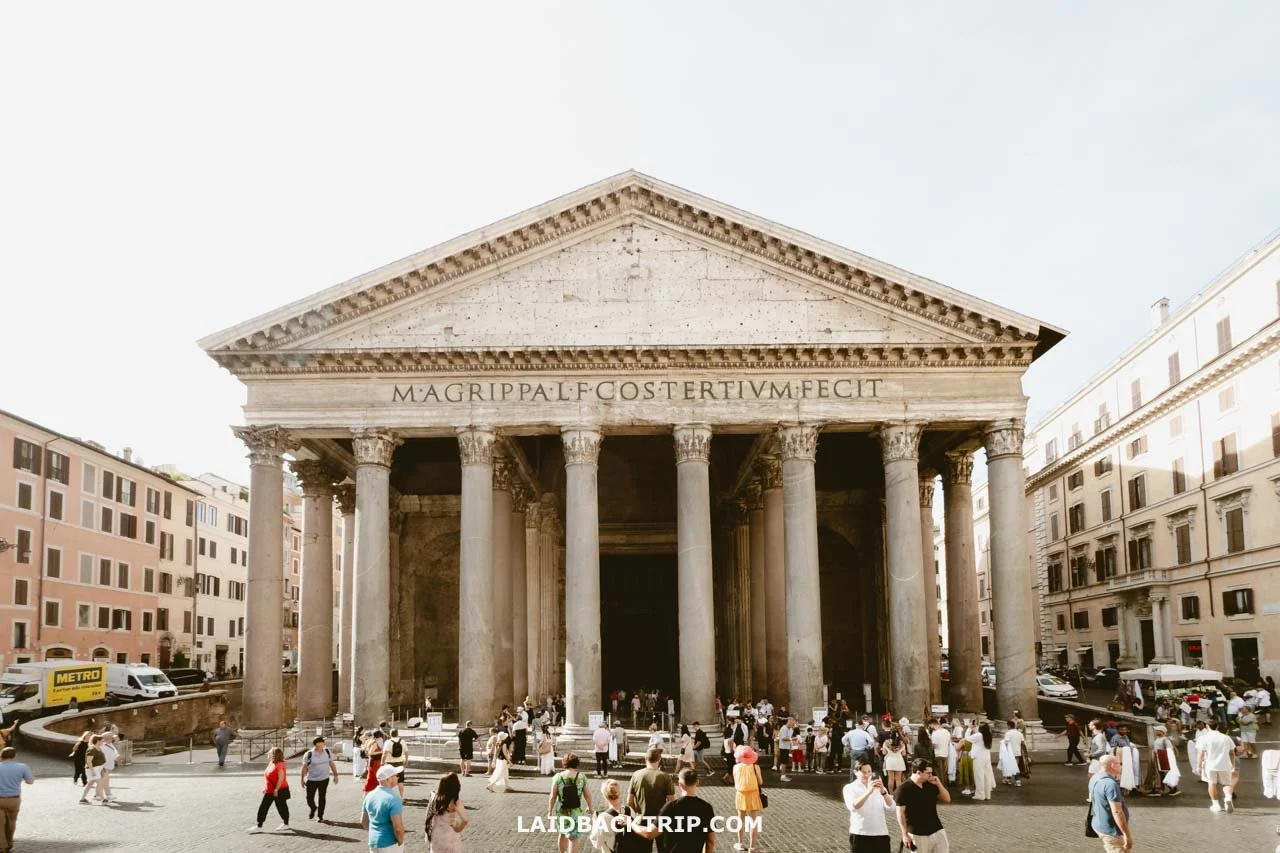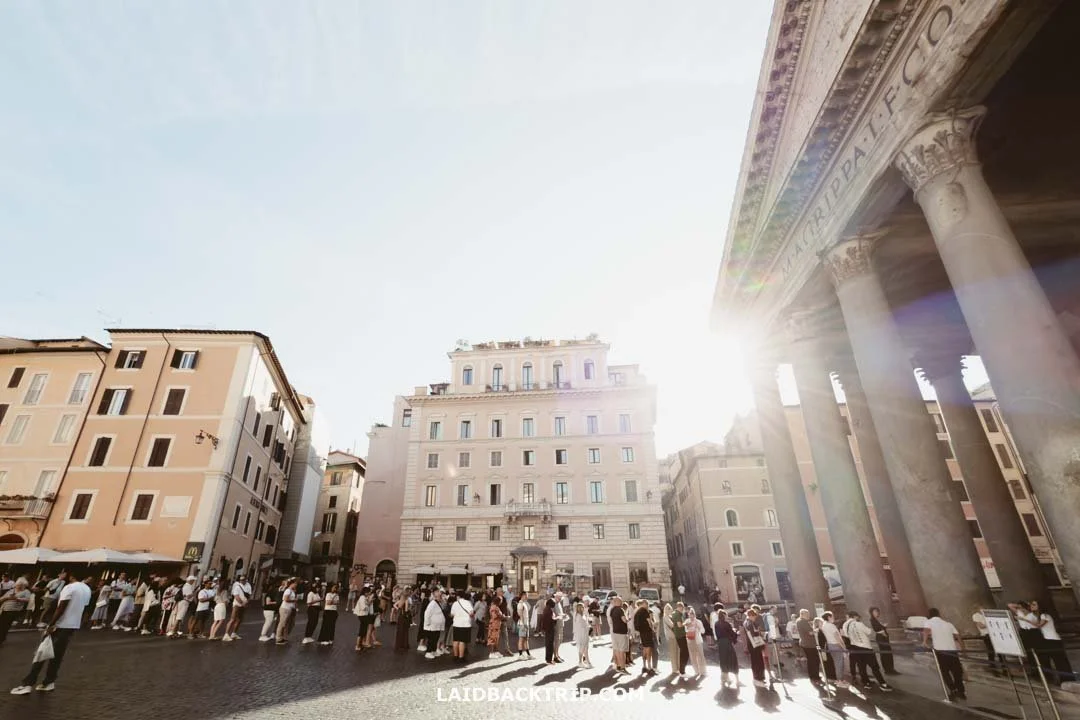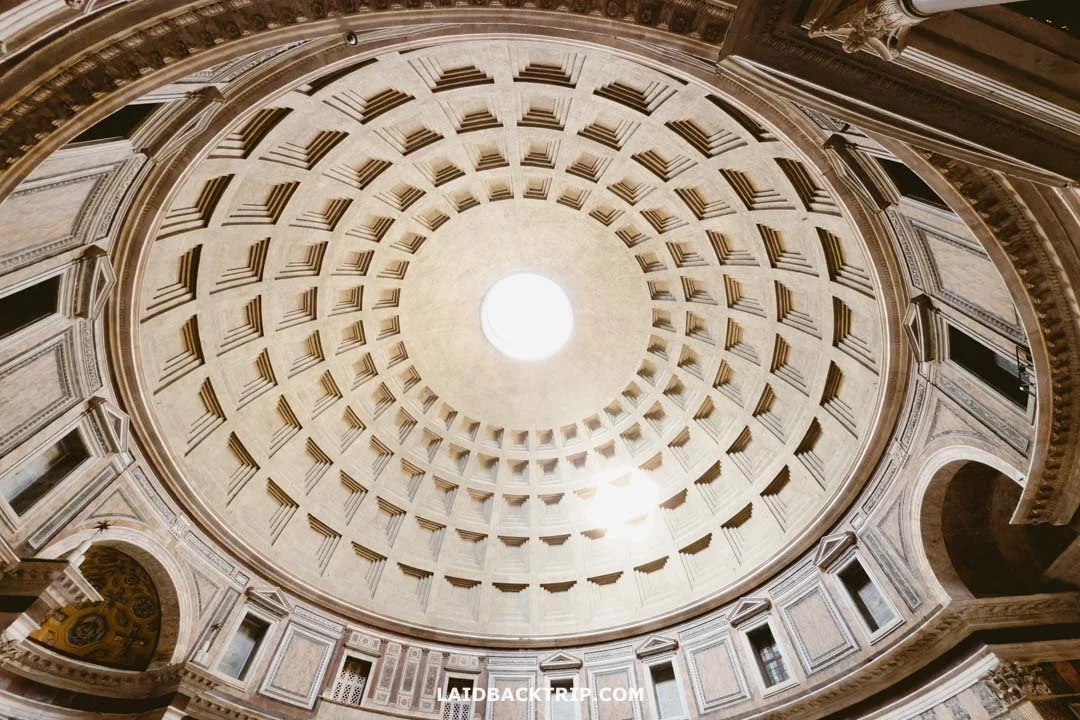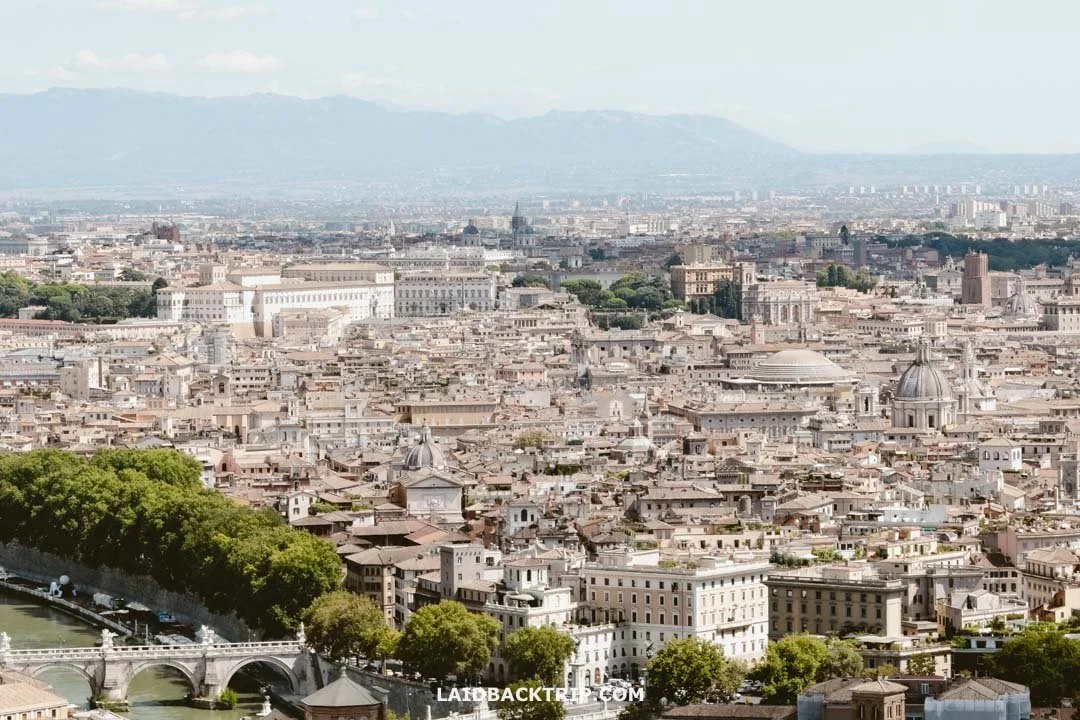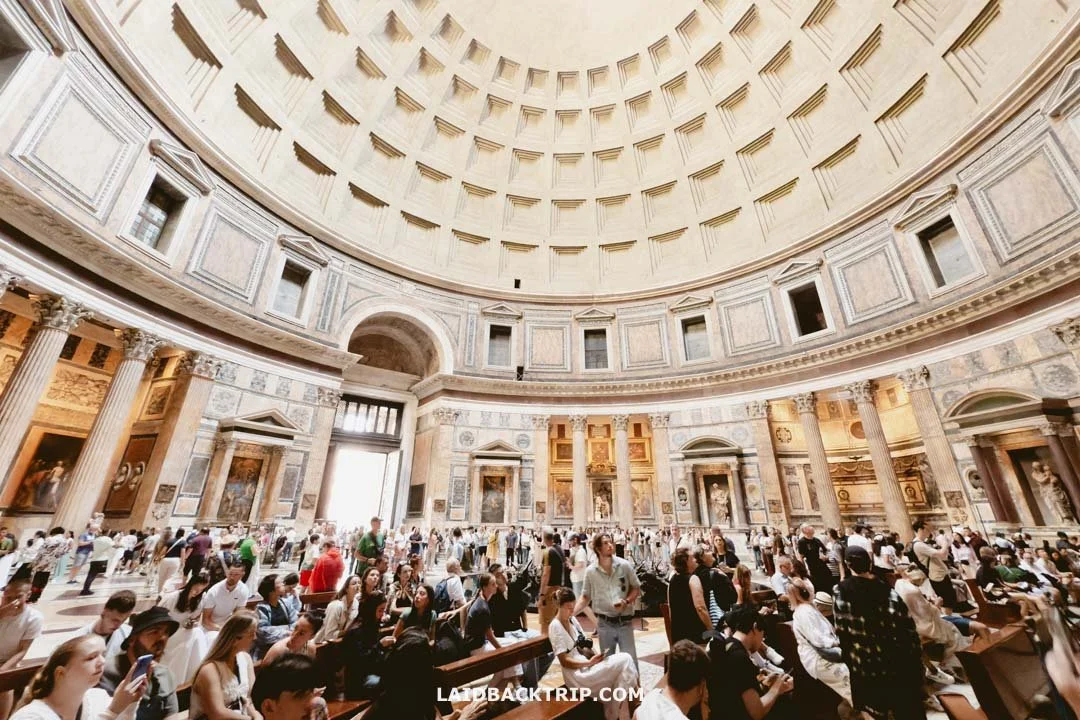Visiting Pantheon in Rome (Without a Guide)
The Pantheon is an ancient temple in the heart of Rome.
For Lucie and me, walking into the Pantheon was like traveling straight into ancient Rome. Come explore one of Rome's must-sees with us!
When I first visited Rome over 20 years ago, after the Colosseum, the Pantheon was the ancient site that impressed me the most. It's easy to see why, since the Pantheon is the best-preserved ancient Roman building in all of Rome, surviving nearly 2,000 years since it was built.
With so much history seeping from its walls and its remarkably preserved state, the Pantheon easily ranks as one of Rome's most famous attractions. Lucie couldn't wait to visit and was honestly really excited about it too.
The funny part was that even though our hotel was right around the corner from the Pantheon and we walked by it several times during the first few days, we somehow always found a reason not to go in yet. It was either too late, too crowded, or we already had plans. We kept saying that since the Pantheon was only a two-minute walk, we could visit anytime. It took us four days to finally change that, get our tickets, and see its stunning interior.
I was really curious to see how the experience had changed over the years. After surviving two millennia, I figured the Pantheon would still be intact since my last visit. But jokes aside, I was more interested in how the visit itself would feel for Lucie, since it was her first time in Rome, and also for me, since my memories were pretty hazy. So here's how our trip to the Pantheon went.
Pantheon is a temple built by the Romans about two thousand years ago.
Opening Hours of Pantheon
Since the Pantheon was open daily from 9 AM to 7 PM all year, we didn't really stress about timing and just decided to visit first thing in the morning since it fit our plans. So we aimed to get there at 9 AM, which wasn't hard at all since our place was only two minutes from the temple.
When to Visit Pantheon
Naturally, we tried to figure out how to skip the lines at the Pantheon. We had kind of checked out the situation in the days before, but honestly, we weren't any smarter after that. And as it turned out, going on a weekday didn't make any difference either.
The Pantheon and Piazza della Rotonda stayed busy no matter the time of day.
We were in Rome in September, and the lines at the Pantheon were about the same length no matter when we passed by. From what we saw, it was hard to guess which time of day was best. We assumed early mornings or late evenings would be ideal, but it turned out that wasn't really the case. At least not in September.
From what we experienced, the usual advice that the best time to visit the Pantheon is during off-peak hours only works in the low season. In summer, it seemed to make no difference since there were always people waiting to enter, even before it opened.
Getting To Pantheon
The Pantheon is located on Piazza della Rotonda in the heart of Rome's historic center. Since we were staying at Hotel Navona, about 250 meters from the Pantheon, we simply walked there.
Later in the trip, we moved closer to Termini and stayed at the Leonardo Boutique Hotel in the Monti neighborhood. Even from there, the Pantheon was only a 15-minute walk.
Piazza della Rotonda, where the Pantheon is located, was also really charming.
The side streets were packed with taxis and shuttle vans bringing tourists to the area all day, but if you're staying in the city center, you can save yourself some money because walking is definitely the best choice. If you plan to take a bus to the Pantheon, we'd suggest getting off at the busy Argentina stop, about 400 meters south of the temple.
Waiting at the Line for Tickets to Pantheon
Even though we arrived right at opening time, there was already a decent crowd waiting in line. Technically, there were two lines for visitors without tickets. The one on the left was cash only, while the one on the right accepted credit cards. Since both were about the same length, we chose the right one where we could pay with our phone.
By the time we got to the Pantheon, people were already waiting in line.
Luckily, since we arrived just before the Pantheon opened, there were no visitors inside yet. Once the doors opened, the line moved fast because the place was still empty, and they allowed everyone to enter once tickets were purchased. So getting there early helped, not because there wasn't a line, but because it moved fast at this time of the day.
Entry Fee to Pantheon
The biggest change from my first visit was that the Pantheon used to be free to enter, but now there's an admission fee. Many details from that trip have faded over the years, but one thing I clearly remember is how we walked into the Pantheon without tickets. But that's no longer the case.
From the side, the Pantheon looked almost like a simple structure.
The entry fee for the Pantheon was €5. While we obviously would have preferred it to stay free, at least the ticket price was still quite reasonable. And since it was no longer free to enter, we had to figure out how to buy the tickets.
Our Tip: There's no admission fee for the Pantheon on the first Sunday of every month, which means you can see this incredible monument for free on those dates!
Buying the Entrance Ticket to the Pantheon
Since we had the Pantheon just around the corner, we decided not to buy tickets in advance and simply showed up early in the morning to avoid the main crowds. We did the same thing at Castel Sant'Angelo, and it worked fine, so we figured it would work the same at the Pantheon too.
It was a good plan, but since the Pantheon was much more famous, didn't open earlier than 9 AM, and sat in the middle of the historic center, there was already a line when we arrived. Of course, we got there only a few minutes before opening, so we kind of expected that.
We got the tickets at the kiosk by the Pantheon's entrance.
Luckily, the line moved fast, and within two minutes, we reached the ticket office on the right-hand side. We bought our tickets for €5 each, paid by card, and stepped into the past. I'd like to say to ancient times, but the Pantheon's history is more complex. More on that later. For now, let's talk about the online tickets in detail.
Buying Pantheon Tickets Online (with Audio Guide)
Since we were visiting one of Rome's top attractions, we also checked if there was an option to buy Pantheon tickets online. And there was, but things got a little tricky with that method. Once again, it's worth noting that the entry fee to the Pantheon is only €5, which matters if you want to avoid scams.
The only official website we found selling Pantheon tickets was Musei Italiani, run by the Ministry of Culture, which manages Italian museums. We clicked on Tickets (priced at €5), searched for the Pantheon, chose an individual ticket, selected the date and time, and proceeded to checkout, though we didn't complete it. Since we were staying just a short walk away, we decided there was no real need to buy online.
Pantheon is now called the Basilica of St. Mary and the Martyrs and, for instance, has a big altar.
The confusing part was that other Pantheon websites, which often looked trustworthy and even used names combining "Pantheon" and "Rome," were actually third-party resellers. A few were upfront about it, but the majority weren't.
The issue was that these sites offered pricier combo tickets, usually starting at €15, which main 'benefit' was that they included, besides the entry, an audio guide. The trick was that they made it seem like this was the only option and like there were no €5 tickets.
In other words, we'd be paying €10 just for a digital audio guide. While I'm not saying an audio guide wouldn't be helpful, it simply wasn't worth that price for us. On top of that, some of them required picking up the ticket and audio guide at a different location, which meant wasting time before even getting inside. This brings me to another topic: guided tours, audio guides, and similar options.
Exploring Pantheon Without a Guide
Like almost every attraction in Rome, we decided to explore the Pantheon on our own. The thing about the Pantheon is that it's really just one hall. A huge one, but still just one (and smaller than St. Peter's Basilica).
So there wasn't much need to plan which way to go, unlike at the Roman Forum or Hadrian's Villa, which were places that required more attention to the planning part. In that sense, the Pantheon was one of the easiest spots we explored in Rome.
Another reason we felt fine without a guide was that, unlike some other Roman ruins, the Pantheon is one of the most famous and best-preserved, which means there's a ton of information about it. And all that information is free.
The Pantheon had these English panels with essential information about it.
Of course, it wasn't narrated, so we had to look things up ourselves, but that wasn't an issue since the temple's history and design have been thoroughly documented. Plus, there were clear and detailed info panels in English inside, which were really helpful.
If you're still thinking about getting the audio guide, there's a Pantheon Roma kiosk inside the temple. I got curious and scanned the QR code there, which took me to the App Store, where the digital audio guide cost €2. That felt a bit odd since in this case, the full experience would only be €7 instead of €15 through their website. Even though it's slightly pricier, we’d likely go for a guided tour of the Pantheon rather than the audio guides if you'd rather not explore on your own.
What's There to See in Pantheon
Obviously, we came to explore the Pantheon's interiors, but the temple was stunning even from the outside. Every time we passed through Piazza della Rotonda, we stopped for a moment to admire this magnificent structure. No matter the angle, this ancient temple never failed to impress us. At least from the front, because from the sides it was pretty simple.
Roman Pantheon's portico features 16 granite columns
The first thing that caught our attention was the portico made up of 16 massive Corinthian columns that give the Pantheon its classic Roman temple appearance. The granite columns were brought from Egypt, each weighing more than 60 tons. We had time to look at them while waiting in line, and they were truly impressive.
Once inside the Pantheon, we were ready to explore its interior. And just a few steps in, we instantly looked up. Above us was the magnificent dome, the temple's most striking feature and a true masterpiece of Roman engineering.
The Pantheon's dome has a diameter of 43 meters.
No matter where we went in Rome, whether it was the Via Appia or the Colosseum, the brilliance of Roman engineering always amazed us. And Pantheon was no exception.
Probably the coolest thing we learned about the Pantheon was that the height from the floor to the oculus equals the dome's diameter, which is 43 meters. To this day, it remains the largest unsupported concrete dome in the world.
The most fascinating feature of the dome was the oculus, a circular opening that represents the connection between heaven and earth, makes the roof lighter, helps with air ventilation, and serves as the only source of natural light (when the main door is closed).
Oculus is the opening at the top of the Pantheon's dome that allows light to enter.
We visited the Pantheon on a bright, sunny day, so we could enjoy the sunlight streaming into the temple, adding to its magical feel. Since we came in the morning in early September, the light illuminated only the dome.
If you visit the Pantheon at noon on April 21, the sunlight from the oculus shines directly on the entrance. On that date, the Roman emperor would make a grand entrance during the celebration of Rome's founding in 753 BCE (Rome was founded on this day in 753 BCE, at least according to legend).
While I was staring up at the dome, Lucie asked what happens when it rains. It was a good question. Apparently, the floor has small holes that drain rainwater into an underground system connected to the sewers. Once again, Roman engineers really did think of everything.
The perfect geometry of the Pantheon's dome also makes it one of the most recognizable landmarks in Rome from afar. Whether we were at St. Peter's Basilica or in Borghese Park, the round silhouette stood out even at great distances. And though nearby church towers looked more ornate, they lacked the pure grandeur of this massive dome.
A day earlier, we got this view of the Pantheon from St. Peter's Basilica.
Since its conversion into a Christian church in 609 CE, the Pantheon has remained a place of worship, with the main altar still in use for services. Inside, there were also small chapels and niches filled with religious statues and artwork, including depictions of saints and the Virgin Mary. The marble floors, decorated with colorful geometric patterns, were beautiful but harder to admire because of the crowds around us.
This is the tomb of Victor Emmanuel II.
The next thing we noticed inside the Pantheon was the tombs of Italy's famous kings Victor Emmanuel II and Umberto I. Along with them lies Queen Margherita, as well as Raphael, the celebrated Renaissance artist whose work we had admired at the Vatican Museums and Borghese Gallery.
And here is where Raphael Santi was laid to rest.
In the center of the temple stood a modern art piece called Corona Gloriae, which was quite interesting, though it blocked off the middle section, so we couldn't stand directly beneath the oculus. What made it even more fascinating was that the artwork acted as a kind of water basin, probably also collecting rainwater that fell through the opening.
A modern art piece called Corona Gloriae was installed in the middle of the Pantheon.
History of Pantheon
After walking around the Pantheon's interior, we decided to take a short break and sat in the seating area near the main altar. Here we could focus on Pantheon's history, which was just as fascinating as its architecture. The name Pantheon means "temple of all gods," though interestingly, its exact original purpose is still debated.
It was first commissioned by Marcus Agrippa in 27 BCE and later rebuilt by Emperor Hadrian around 118–125 CE after fires damaged the earlier version. In 609 CE, the Pantheon was consecrated as a Christian church, which helped protect it through the centuries. It was renamed the Basilica of St. Mary and the Martyrs (Basilica di Santa Maria ad Martyres), though the majority of tourists still simply call it the Pantheon.
The seating area in front of the main altar.
This pattern is actually pretty common in Rome. In the Roman Forum, one of the best-preserved buildings is the Curia Julia, the ancient senate house, which survived mostly intact because it was also converted into a church, just like the Pantheon. What we found interesting was that the Pantheon still functions as a Catholic church today, and masses are regularly held there (and you can attend if you'd like).
Crowds at Pantheon
Because the Pantheon was among the most popular places we visited in Rome, we naturally expected crowds. It was kind of unavoidable. Even though we got there early, the temple filled up fast with visitors, making it one of the busiest spots we saw on the trip. But despite all the people around us, it didn't have any negative effect on our experience. It was simply a busy tourist spot.
Even in the morning, the Pantheon was really busy.
As I said before, it's hard to avoid the crowds, especially if you're visiting in peak season like we were. Unless you go in the queit months such as January or February, it really just comes down to luck how crowded it'll be. One last thing worth mentioning is that with larger crowds, we had to be extra careful about pickpockets. It's a busy area, so keep an eye on your phone and wallet here!
World Nomads provides travel insurance for travelers to cover their trip essentials, including sports and adventure activities.
SafetyWing is affordable travel insurance for backpackers, long-term travelers, and digital nomads.
How Much Time to Set Aside For Pantheon
We spent about 45 minutes in the Pantheon, including a 15-minute break when we just sat inside the temple and read about it. Obviously, it's just one hall, so we could have explored it in a much shorter time, but we took things slow and enjoyed being there.
Of course, we also spent about 2 or 3 minutes in line to buy the tickets and another 10 minutes wandering around the temple afterward. Honestly, we spent even more time outside the Pantheon since we passed by it several times during the trip. So, all in all, an hour for the Pantheon should be plenty for most visitors.
We spent about an hour in the Pantheon since we wanted to see everything it offers.
Is Pantheon Worth Seeing?
The Pantheon was easily one of our top must-sees in Rome, and because our hotel was close by, we came back a few times. Each visit, whether we stepped inside or just admired it from the square, was amazing. Simply, this was truly one of the most remarkable Roman sites we saw in the historic center.
What made the Pantheon so special was that it wasn't simply a ruin like the Baths of Caracalla or Domitian's Stadium, but a temple that had stood for 2,000 years almost untouched, despite its later conversion to a church. The only slight drawback was the entry fee, but honestly, it was still absolutely worth going inside.
Travel Resources
Here you can find links to all the travel resources we use and which you might find helpful when planning your next holiday.
Accommodation: When looking for accommodation, we usually search hotels via Booking.com or Hostelworld.
Tours: Although we love to travel independently, some places are better to visit with a guided tour.
We prefer GetYourGuide for its easy-to-use interface and solid reputation. Another great alternative is Viator.
Rental Cars: When going on a road trip, we always use Rentalcars.com, a reliable site for booking a rental car in advance.
Flight Tickets: When looking for flight tickets, you can search Skyscanner to find the best price.
Travel Insurance: World Nomads and SafetyWing cover against risks of travel.
